
How to choose a bass drum pedal
Contents
Jazz emerges at the end of the 19th century . Around 1890, drummers in New Orleans began to tailor their drums to suit the conditions of the stage so that one performer could play several instruments at once. Early drum kits were known by the short promotional name “trap kit”.
The bass drum of this setup was kicked or a pedal without a spring was used , which did not return to its original position after being hit, but in 1909 F. Ludwig designed the first bass drum pedal with a return spring.
The first double bass drum pedal was released by Drum Workshop in 1983. Now drummers do not have to use two bass drums, but just put one on and play it with two pedals at once.
In this article, the experts of the store “Student” will tell you how to choose the bass drum pedal that you need, and not overpay at the same time.
Pedal device

Beater
Bass drum beaters come in many varieties. In fact, this is a hammer that hits the drum. Depending on the size and shape of the mallet, the drummer can produce one or another sound.
A larger mallet tends to produce a louder sound from the drum. The flatter surface gives a little more attack. However, a completely flat beater head is rare, as it is likely that it will hit the head of the drum at an angle and, in the end, wash it out.
Therefore, usually either the beater head has a bulge to compensate for the change in the angle at which it hits the head, or beaters with a flat contact surface have a swivel head.
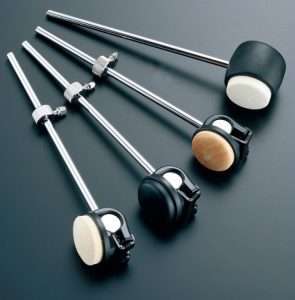
A swivel head for any mallet (except, of course, absolutely round heads) is more of a plus than a minus. The fixed fastener simplifies the production of the pedal and reduces the cost of it. However, the depth of bass drum hoops is variable, non-standard, and the angle at which the beater strikes the head varies from pedal to pedal.
The sound of a bass drum, in addition to shape and size, is affected by the material from which the mallet is made. A hard surface (like wood or plastic) gives more attack, while a softer surface (like rubber or felt) gives a quieter, more fluid sound. It all depends on the style of music and the preferences of the drummer. Jazz drummers, for example, use special beaters made from soft lamb’s wool because of the warm tone they produce from the bass drum .
Footboard
Footboard – a platform on which the drummer’s foot is placed; is of two types:
1. split footboard, where the longer front section and short heel joint are articulated, more common;

Footboard with split construction
2. a long one-piece footboard (often simply called a “longboard”, from the English longboard – “long board”), hinged behind the heel area.
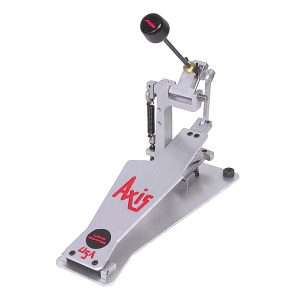
Longboard pedal
Long footboard pedals have a lighter, more responsive ride and have become popular with metal drummers whose feet require the fastest pedal, and players who use the heel-toe technique, which is much easier to use on a logboard. However, drummers looking for more volume and power may prefer the ruggedness of a split pedal design. Some manufacturers go to the trick here and offer either a choice or 2 in 1 models.
Another important characteristic of a footboard is its surface texture. If you play barefoot or in socks, a textured footboard ( such as one with raised logos, large stylized holes, or textured bumps) will not feel as comfortable as a smoother footboard. And if you use the same bass drumming technique as Dave Weckl (Dave Weckl is one of the most respected drummers in the world), where the foot slides forward when playing deuces and trebles, then overly pronounced texture can interfere with good playing.
Pedal stroke control: cam (cam)
On most pedals, the beater is connected to the footboard through a cam (cam) via a chain or belt drive . The shape of the cam, along with pedal tension, has the greatest effect on pedal travel.
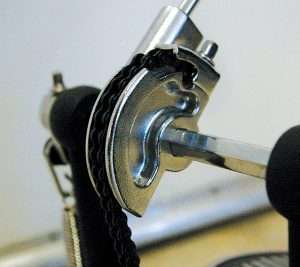
1. If the cam has a perfectly round shape , this gives a completely predictable reaction: what efforts you make, you get such a result. However, like the gears on a bicycle, a large diameter cam turns more easily and feels less heavy than a smaller cam.
2. Another common cam shape is oval, or oblong , which contributes to a faster stroke and a louder sound. While this shape may require a bit more force to propel, it actually creates an acceleration effect after the pedal has already been actuated. The differences between these two forms may be subtle to the eye, but your feet will notice them without difficulty.
Drive system
In total, there are three main types of drive for connecting the footboard to the cam and beater assembly:
- belt,
- chain
- direct drive (or Direct Drive – solid metal section)
Leather belts – once the most common form of transmission – had an unfortunate tendency to fray and tear, and in later years they were replaced by fiber reinforced belts.
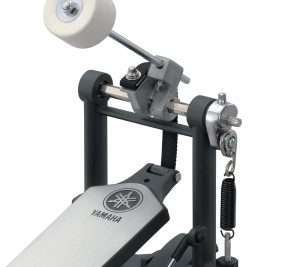
Belt drive
Chain driven pedals use a bicycle chain (usually one or two back to back); such pedals gained popularity a couple of decades ago due to their impressive appearance and durability. However, they also have their drawbacks: they can get dirty, they are not easy to clean (if you have not enough patience), and they also make some noise. And then, chains tend to have a slightly heavier feel than belt-driven pedals.
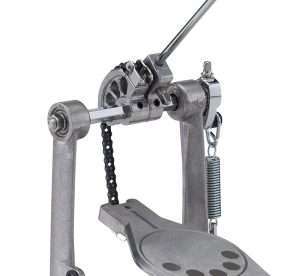
chain drive
Today, most companies produce pedals with a combined drive , when the chain can be changed to a belt and vice versa. Thus, using the same pedal, you can choose which option you like best.
Direct drive pedals have a solid metal section gear (corner brace) between the footboard and the beater assembly, eliminating the need for a cam. These pedals eliminate even the slightest delay that can occur with chain or belt driven pedals. Although most direct drive pedals offer a variety of options for adjusting travel and overall feel, their adjustment range is usually narrower than other types of pedals. In addition, along with the increase in speed with direct drive, unfortunately, the impact power is greatly reduced .
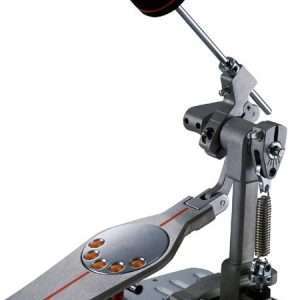
direct drive
Cardan
In modern rock music, especially in the style of metal rock, a cardan (or double pedal) is often used to hit the bass drum, which allows you to play the bass drum with both feet, which means you hit it twice as often, than when playing with one pedal. Cardan allows you to replace two bass drums with one.

The advantages of cardan are clear. The first is the ability to play with two feet on the same kick drum for speed. Accordingly, convenience during tours and live concerts, when it is possible to use one bass drum instead of two.
The disadvantages of using a cardan shaft are small and easy to prevent:
1. The gear ratio from the left pedal experiences more resistance due to the cardan shaft, which means that the left beater works a little “harder”. In order to negate this minus, it is necessary to develop the left leg and use machine oil to lubricate the cardan shaft parts and reduce friction. An important role is played by the cardan model a.
2. When recording a gimbal , the left kick is quieter than the right. Firstly, because the left leg is weaker, and secondly , because of the same resistance of the cardan shaft. There is a way out of this situation: it is necessary to placegimbal so that the center of the bass drum is hit by the left mallet, not the right. It turns out the same dynamics, and the sound is similar to the sound of two bass drums.
How to choose a pedal
Pedal Examples
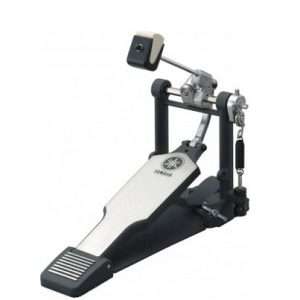 YAMAHA FP9500D |  TAMA HP910LS SPEED COBRA |
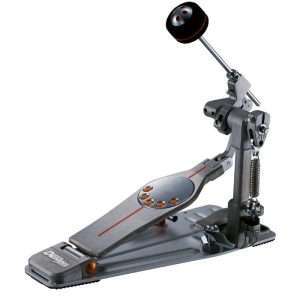 PEARL P-3000D | 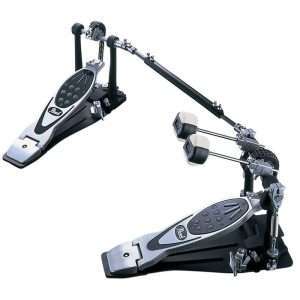 PEARL P-2002C |





